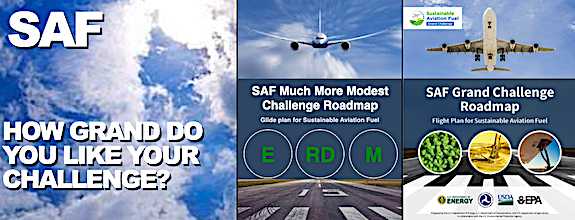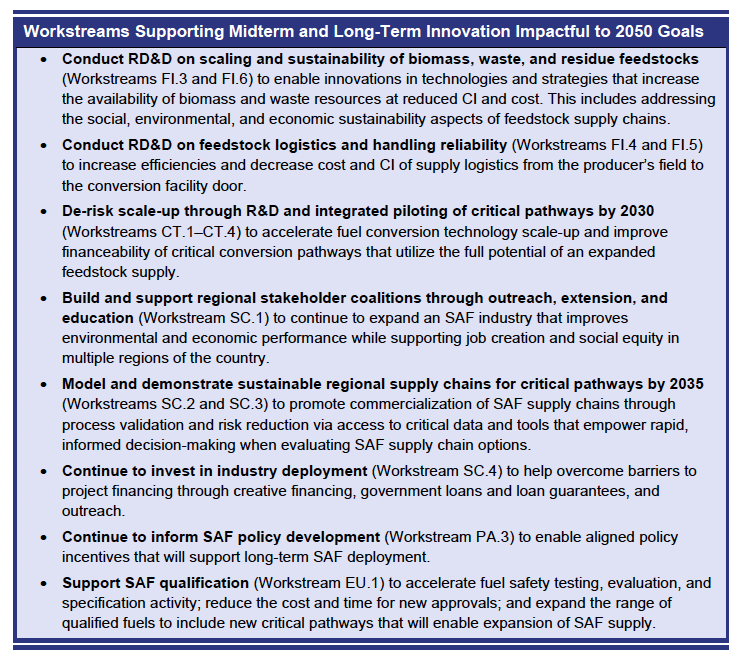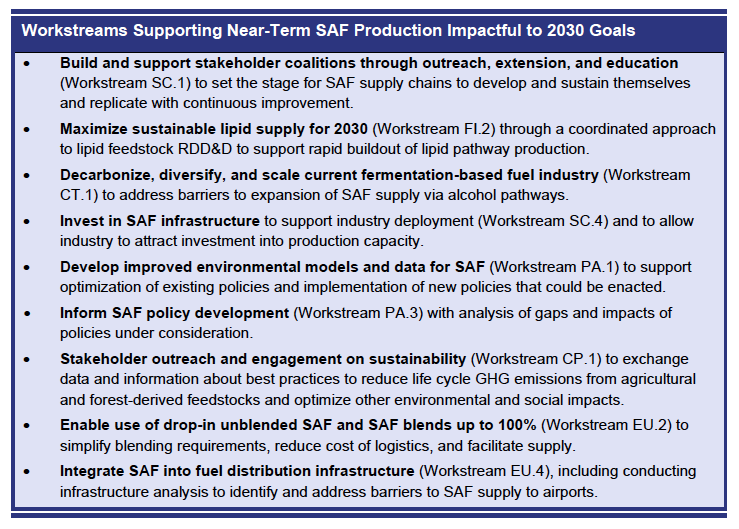The Sustainable Aviation Fuel Grand Challenge Roadmap

The Sustainable Aviation Fuel Grand Challenge is a U.S. government-wide approach to work with industry to reduce cost, enhance sustainability, and expand production to achieve 3 billion gallons per year of domestic sustainable aviation fuel production that achieve a minimum of a 50% reduction in life cycle greenhouse gas emissions (GHG) compared to conventional fuel by 2030 and 100% of projected aviation jet fuel use, or 35 billion gallons of annual production, by 2050.
To reduce aviation greenhouse gas emissions, the aviation sector is pursuing a combination of aircraft technology, operational improvements, offsetting, and sustainable aviation fuel. This approach is reflected in the United States 2021 Aviation Climate Action Plan,2 which lays out the U.S. government strategy to build on sector-wide industry commitments to foster innovation and drive change across the entire U.S. aviation ecosystem and meet a goal of net-zero GHG emissions from U.S. aviation by 2050. SAF is “drop-in” liquid hydrocarbon jet fuel produced from renewable or waste resources that is compatible with existing aircraft and engines. The plan recognizes that SAF offers a critical near-term solution to reduce greenhouse gas emissions and decouple aviation’s growth from its carbon emissions.
Developing innovative technologies to produce SAF will enable the United States to meet its domestic climate goals for the U.S. economy and position it as a global leader in the emerging SAF market. The United States also has the potential to be an exporter of SAF technology and fuels to support other countries in their efforts to decarbonize aviation globally. Finally, SAF supports long-term viability of the U.S. airline and aerospace industries and is a critical component of U.S. strategy in the United Nations’ International Civil Aviation Organization (ICAO).
SAF are hydrocarbon fuels and thus emit carbon dioxide when combusted in the aircraft engine. The extent to which any particular SAF provides emission reductions depends on the life cycle emissions profile, taking into account the production, transportation, and combustion of the SAF, as well as indirect effects associated with these. The SAF Grand Challenge requires fuels to reduce emissions by at least 50 percent on a life cycle basis compared to jet fuel, and has workstreams and actions dedicated to increasing the emissions reductions possible from the production, blending, and distribution of SAF. Additional benefits are expected as some types of SAF reduce emissions that impact air quality and contribute to the formation of contrails, which also impacts climate change.
Based on the joint Billion-Ton Report from the U.S. Department of Energy (DOE) and U.S. Department of Agriculture (USDA), about 1 billion dry tons/year of biomass can be grown or collected sustainably.3 DOE estimates that this amount of biomass could be converted into 50–60 billion gallons of advanced biofuels without impacting agriculture, trade, or current uses of biomass. Further, as ground transport electrifies, SAF presents a potential market for existing biofuels. In addition to biomass sources, waste gaseous sources of carbon are potential SAF feedstocks. Combined, there is sufficient feedstock to meet the projected needs of the U.S. aviation industry if cost, sustainability, and production barriers can be addressed.
Successful implementation of the SAF Grand Challenge will require close collaboration of agencies across the federal government— particularly DOE, USDA, U.S. Department of Transportation (DOT) and its Federal Aviation Administration (FAA), and U.S. Environmental Protection Agency (EPA). The roles for these agencies have been spelled out in the SAF Grand Challenge memorandum of understanding. DOE is researching and developing sustainable fuel production technology, providing support for technology scale-up and advancing environmental analysis of SAF. USDA is developing feedstocks suitable for SAF and supporting commercialization. DOT has capabilities in fuel qualification and certification, U.S. and international standard-setting, transportation infrastructure, and stakeholder outreach. EPA is working directly with all three agencies on existing regulations that can support SAF production. Working within the structure of the interagency Biomass Research and Development Board,4 an interagency working group on SAF has been established to enable coordination with representatives of a broader set of government agencies.
SAF Grand Challenge Roadmap Overview
An interagency team led by the DOE, DOT, and USDA worked with EPA, other government agencies, and stakeholders from national labs, universities, nongovernmental organizations (NGOs), and the aviation, agricultural, and energy industries to develop this SAF Grand Challenge Roadmap.
The roadmap outlines a whole-of-government approach with coordinated policies and specific activities that should be undertaken by the federal agencies to support achievement of both the 2030 and 2050 goals of the SAF Grand Challenge. This roadmap ensures alignment of government and industry actions and coordinate government policies to achieve the goals of the SAF Grand Challenge. This includes coordination in the formation and execution of plans in research, development, demonstration, and deployment (RDD&D) such as modeling and analysis to ensure sharing of approaches, tools, assumptions, and insights across agencies’ research centers at the DOE national laboratories, FAA’s Center of Excellence for Alternative Jet Fuels and Environment (ASCENT), and USDA’s Agricultural Research Service, Forest Service, and National Institute of Food and Agriculture.



The roadmap lays out six action areas spanning all activities with the potential to impact the SAF Grand Challenge objectives of (1) expanding SAF supply and end use, (2) reducing the cost of SAF, and (3) enhancing the sustainability of SAF:
1. Feedstock Innovation (FI)
2. Conversion Technology Innovation (CT)
3. Building Supply Chains (SC)
4. Policy and Valuation Analysis (PA)
5. Enabling End Use (EU)
6. Communicating Progress and Building Support (CP).
Within each of the six action areas are workstreams that define critical topics to be addressed. Appendix A includes descriptions of granular activities within each workstream that can be pursued. During fiscal year 2023, public–private implementation teams will be formed around these action areas and workstreams. Throughout the remainder of the SAF Grand Challenge time frame, these implementation teams will further assist in developing and refining lists of goals, activities, and timelines commensurate with expected progress on action areas and workstream efforts, as well as identification of new needs.
This roadmap is the beginning of an iterative, collaborative, and necessarily dynamic process. Regular updates are anticipated as research advances, technologies progress, markets develop, and agencies progress toward the SAF Grand Challenge goals.
SAF Grand Challenge Actions and Impact
Meeting the two SAF Grand Challenge goals of 3 billion gallons of SAF per year by 2030 and 35 billion gallons of SAF per year by 2050 will require sets of activities that differ in focus to impact the two different periods. Key actions in support of 2030 and 2050 production and GHG reduction goals are identified on the following pages.
Key Actions To Support 2030 Production
Given the limited time—less than 8 years—to meet the 2030 goal, and considering the time required for SAF production infrastructure to be built, the path to meeting the 2030 goals requires an immediate focus on commercially ready conversion technologies and feedstocks. Lipid-based pathways (fats, oils, and greases) are expected to be the primary fuel pathway leading up to 2030, with a smaller contribution from waste, forest and agricultural residue, and alcohol pathways by 2030.
It is important to note that additional policy incentives may be necessary to achieve rapid scaling to meet the 2030 goal. This roadmap includes executive agency activities in support of policy analysis and tools to inform new policy implementation that will increase production of SAF and reduce aviation sector GHG emissions. President Biden, working with Congress, signed the Inflation Reduction Act (IRA) into law on August 16, 2022 (see text box below). This legislation provides powerful first steps to incentivize companies across the aviation industry and the fuel supply chain to move aggressively to shift toward a low-carbon future, and to hire American workers to get the job done.
Key Actions To Support 2030–2050 Production
The path to meet the goals beyond 2030 to 2050 requires a continuing focus on supporting ongoing innovation, including research, development, and demonstration (RD&D) of new feedstock and conversion technologies with potential for exponential growth in production capacity, greater emissions reductions, and reductions in cost of production and carbon intensity (CI) after 2030. This effort must occur simultaneously with the 2030-focused activities to develop a portfolio of solutions that can come into production after 2030 and be sequentially scaled to meet the ambitious fuel production needs through to 2050. Technologies in this portfolio are expected to result in a dramatic buildout and expansion of alcohol, waste-based, lignocellulosic, and waste and captured carbon gas pathways.
Summary
The ultimate goal of the SAF Grand Challenge is to reduce GHG emissions in the aviation sector by supporting the creation of an environment where feedstock producers adopt best practices to reduce emissions, regional collaborations come together to maximize economic and social benefits in developing SAF, and fuel producers ultimately choose to produce and sell SAF to aviation industry end users. As previously noted, further legislative action to reduce cost and risk will likely be necessary to meet the goals. The SAF Grand Challenge Roadmap creates a coordinated approach to federal actions that will increase emissions reductions; de-risk technology, supply chains, and markets; and reduce barriers. This is being carried out with activities that support near-term production to meet 2030 goals, as well as ongoing innovation to support future production to meet 2050 goals. In addition, the roadmap provides a focus on setting up demonstrations of supply chains, investing in production infrastructure, collecting data and performing analysis to support markets for SAF through strong policies, and eliminating barriers to enable distribution and end use of SAF. Finally, the roadmap prioritizes engagement with stakeholders to build support and communicate on progress of the SAF Grand Challenge. In combination, these actions can support industry to build out and use a dramatically expanded U.S.-based SAF supply.
The Sustainable Aviation Fuel Grand Challenge Roadmap affirms that the Government, across multiple agencies, is committed to the substantial emissions reductions that can be achieved through SAF research, development, and deployment. It is a plan for continuing, long-term, and substantial assistance and action.
The Sustainable Aviation Fuel Much More Modest Challenge Roadmap
As the authors of this impressive 126-page study note in their opening remarks:
“Sustainable Aviation Fuel Grand Challenge is a U.S. government-wide approach to work with industry to reduce cost, enhance sustainability, and expand production to achieve 3 billion gallons per year of domestic sustainable aviation fuel production that achieve a minimum of a 50% reduction in life cycle greenhouse gas emissions (GHG) compared to conventional fuel by 2030 and 100% of projected aviation jet fuel use, or 35 billion gallons of annual production, by 2050.”
A long sentence, for sure, a challenge, yes, but how grand?
Seems to me that we can sum up the challenge in about 126 words. Here goes.
1. Convert 3.1 billion gallons of available domestic fuel ethanol to 1.5 billion gallons of SAF by 2030, at 3 refineries each producing 500 million gallons from 1.05 billion gallons of ethanol intermediate.
2. Develop a sustainable, affordable incentive that persuades the makers of renewable diesel (and have some 8+ billion gallons of domestic US production on the planning board) to make 20% SAF in their fuel configuration.
3. By 2030, demonstrate and deploy alternative technologies that utilize biomethane or its precursors to make SAF. Provide loan guarantees for the first deployment of those technologies. Design incentives to bridge any cost differential between conventional jet and SAF.
4. If #2 fails, double #1.
5. Deploy at scale, rinse and repeat, until the 2050 goal is achieved.
Category: Top Stories















